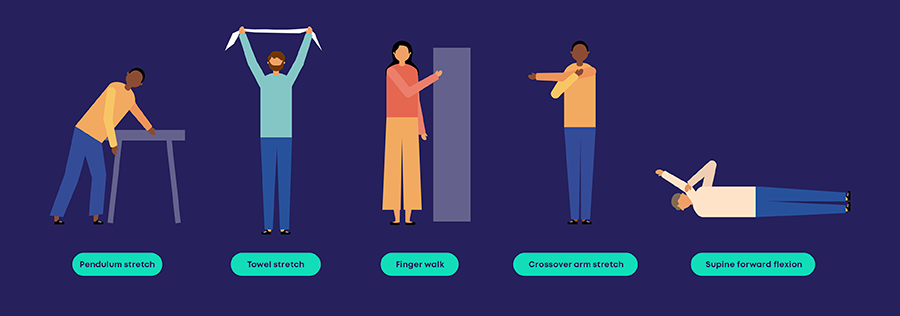You can’t lift your arm like you used to — and it’s getting worse.
Maybe it started with a subtle ache when reaching for something on a high shelf. Or perhaps you noticed a strange tightness when trying to fasten your bra or reach for your wallet in your back pocket. At first, you dismissed it. A pulled muscle, perhaps. Something that would resolve on its own.
But frozen shoulder doesn’t work that way.
Leave it untreated, and daily tasks become a painful challenge. Driving becomes difficult. Getting dressed turns into a morning ordeal. Simple activities like brushing your hair or sleeping on your affected side can trigger sharp, persistent pain. What begins as mild discomfort can progress into months — even years — of debilitating stiffness and lost mobility.
The good news? Frozen shoulder treatment through physiotherapy can reverse this condition when caught early, preventing permanent damage and restoring your quality of life.
What Is Frozen Shoulder? Understanding the Condition
Frozen shoulder, medically known as adhesive capsulitis, is a condition characterized by stiffness, pain, and severely restricted range of motion in the shoulder joint. The shoulder capsule — the connective tissue surrounding the joint — becomes thick, tight, and inflamed, forming adhesions that restrict movement.
Think of it like shrink-wrap slowly tightening around your shoulder joint. As the capsule contracts, it literally “freezes” your ability to move your arm freely.
Who Gets Frozen Shoulder?
While anyone can develop frozen shoulder, certain factors increase your risk:

- Age and gender: Most common in people aged 40-60, with women affected more frequently than men
- Diabetes: People with diabetes are 2-4 times more likely to develop frozen shoulder
- Thyroid disorders: Both hyperthyroidism and hypothyroidism increase risk
- Cardiovascular disease: Heart conditions correlate with higher incidence
- Previous injury or surgery: Prolonged immobilization after shoulder injury, stroke, or surgery
- Parkinson’s disease: Neurological conditions can trigger the condition
The Three Stages: How Frozen Shoulder Progresses
Frozen shoulder doesn’t happen overnight. It develops through three distinct stages, and recognizing where you are in this progression is crucial for effective frozen shoulder treatment physiotherapy.
Stage 1: Freezing Stage (2-9 Months)
This is when most people first notice something is wrong — and when early intervention matters most.
Early warning signs:
- Gradual onset of shoulder pain that worsens at night
- Progressive loss of range of motion in all directions
- Pain that radiates down the arm
- Difficulty with overhead activities
- Increasing discomfort when lying on the affected shoulder
During this stage, your shoulder is becoming increasingly painful and stiff. The shoulder capsule is inflaming and beginning to thicken. Many people wait during this phase, hoping it will resolve spontaneously. This is a costly mistake. Early physiotherapy intervention during the freezing stage can prevent progression to more severe stages.
Stage 2: Frozen Stage (4-12 Months)
In this phase, pain may actually decrease, but stiffness becomes the dominant problem.
Characteristics:
- Severe limitation of shoulder movement
- Daily activities become significantly impaired
- Less pain at rest, but movement remains restricted
- Shoulder feels “stuck” in position
- Muscle atrophy may begin from disuse
The frozen stage is the most frustrating for patients. Your shoulder feels locked, and simple tasks become complex challenges. Without proper frozen shoulder treatment physiotherapy, patients can remain stuck in this stage for a year or longer.
Stage 3: Thawing Stage (12-42 Months)
Gradual improvement begins, but recovery without treatment is painfully slow.
What happens:
- Shoulder range of motion slowly improves
- Pain continues to decrease
- Functional abilities gradually return
- Full recovery can take 2-3 years without treatment
Here’s the critical point: while frozen shoulder can eventually resolve on its own, waiting 2-3 years for natural recovery means years of disability, lost productivity, and diminished quality of life. Physiotherapy can dramatically accelerate this process, shortening recovery time to months rather than years.
Early Warning Signs You Shouldn’t Ignore
Frozen shoulder gives you clues before it fully takes hold. Recognizing these early signs and seeking frozen shoulder treatment physiotherapy immediately can make the difference between a 3-month recovery and a 3-year struggle.
Red flags that demand immediate attention:
- Progressive difficulty with specific movements: You notice increasing trouble with actions like reaching behind your back, putting on a coat, or washing your hair
- Night pain that disrupts sleep: Shoulder pain that wakes you up or prevents you from sleeping on the affected side
- Gradual loss of range: Week by week, you lose a little more mobility in your shoulder
- Compensation patterns: You start using your body differently — bending at the waist to pick things up instead of reaching, for example
- Bilateral symptoms: Pain or stiffness developing in the opposite shoulder (frozen shoulder can affect both shoulders, though usually not simultaneously)
The “Apley scratch test” you can do at home:
- Reach your affected arm behind your head and try to touch the opposite shoulder blade
- Reach your affected arm behind your back and try to touch the opposite shoulder blade
- If either movement is significantly limited or painful compared to your other arm, seek professional evaluation
Why Waiting Is the Worst Strategy
Many people adopt a “wait and see” approach with shoulder pain. This is particularly dangerous with frozen shoulder for several reasons:
The progression paradox: Unlike many injuries that improve with rest, frozen shoulder worsens without intervention. The capsule continues tightening, adhesions multiply, and muscles weaken from disuse.
The compensation cascade: As your shoulder freezes, your body compensates. You start moving differently, which creates new problems in your neck, upper back, and opposite shoulder. What began as a single-joint issue becomes a whole-body movement dysfunction.
The psychological toll: Chronic pain and disability lasting years can lead to depression, anxiety, and decreased overall health. The impact on work, relationships, and self-image is profound.
The economic cost: Lost work productivity, multiple doctor visits, potential need for more invasive interventions if conservative treatment is delayed — the financial impact compounds over time.
Frozen Shoulder Treatment Physiotherapy: How It Works
Physiotherapy is the gold standard for frozen shoulder treatment, with research consistently showing superior outcomes compared to a wait-and-see approach. Here’s how physiotherapists address each aspect of the condition:
Comprehensive Assessment
Your physiotherapist begins with a thorough evaluation:
- Detailed movement analysis to determine stage and severity
- Strength testing of shoulder and surrounding muscles
- Postural assessment to identify compensatory patterns
- Pain mapping to understand symptom distribution
- Functional evaluation of how frozen shoulder impacts your daily life
This assessment guides the creation of your personalized treatment plan.
Manual Therapy Techniques
Skilled hands-on treatment helps restore mobility:

Joint mobilization: Gentle, specific movements applied to the shoulder joint to improve capsular mobility and reduce adhesions. Your physiotherapist uses graded techniques, starting gentle and progressively advancing as your tolerance improves.
Soft tissue mobilization: Targeted massage and myofascial release to address muscle tightness, improve circulation, and reduce pain. This includes work on the rotator cuff muscles, pectoral muscles, and upper back.
Passive range of motion: The therapist moves your arm through available ranges to maintain and gradually expand mobility without triggering protective muscle spasm.
Therapeutic Exercise Progression
Exercise is the cornerstone of frozen shoulder recovery, but it must be carefully prescribed and progressed:

Pendulum exercises: Gentle, pain-free movements that use gravity to maintain mobility without stressing the capsule. These are often prescribed early in treatment.
Active-assisted exercises: Using your unaffected arm, a pulley system, or a cane to help move the frozen shoulder through increasingly larger ranges.
Stretching protocols: Specific stretches targeting the tight capsule and surrounding muscles. These may include cross-body stretches, doorway stretches, and towel stretches performed multiple times daily.
Strengthening exercises: As mobility improves, resistance training rebuilds the muscles weakened by disuse. This includes rotator cuff strengthening, scapular stabilization, and functional movement patterns.
Pain Management Strategies
Managing pain is essential for maintaining treatment compliance and quality of life:
Therapeutic modalities: Your physiotherapist may use heat therapy, ice application, ultrasound, or electrical stimulation to reduce pain and inflammation.
Education on activity modification: Learning how to perform daily tasks with less stress on the shoulder while maintaining as much function as possible.
Sleep positioning: Strategies to minimize night pain, including optimal pillow placement and sleeping positions.
Progressive Functional Training
Treatment doesn’t just restore movement in the clinic — it prepares you for real life:
Task-specific training: Practicing the actual movements you need for work, home, and recreation Movement pattern retraining: Correcting the compensatory strategies you developed and restoring normal, efficient movement Return to activity planning: Gradual, safe progression back to all your previous activities
Advanced Treatment Options in Physiotherapy
For resistant cases or faster recovery, physiotherapists may incorporate advanced techniques:

Dry needling: Insertion of thin needles into trigger points to release muscle tension and reduce pain Instrument-assisted soft tissue mobilization: Using specialized tools to break down adhesions and scar tissue Proprioceptive neuromuscular facilitation (PNF): Advanced stretching techniques that use neurological responses to increase range of motion Neuromuscular re-education: Specific exercises that retrain optimal movement patterns and muscle recruitment
What to Expect: Timeline and Outcomes
The duration of frozen shoulder treatment physiotherapy varies based on several factors:
If caught in the freezing stage (early intervention):
- Typical treatment duration: 2-4 months
- Expected outcome: Prevention of progression to frozen stage, minimal long-term impact
- Frequency: 2-3 sessions per week initially, transitioning to home program
If treated during frozen stage:
- Typical treatment duration: 4-8 months
- Expected outcome: Significant improvement in mobility and pain, possible full recovery
- Frequency: 2 sessions per week with consistent home exercise program
If treated during thawing stage:
- Typical treatment duration: 3-6 months
- Expected outcome: Accelerated recovery, return to normal function
- Frequency: 1-2 sessions per week with progressive home program
Research shows that patients who engage in physiotherapy consistently achieve better outcomes than those who don’t, with faster recovery times and lower recurrence rates.
Your Home Program: The Key to Success
While in-clinic treatment is important, your home exercise program is where the real magic happens. Success in frozen shoulder treatment physiotherapy requires commitment to daily exercises:
Morning routine (10-15 minutes):
- Pendulum exercises to start the day
- Gentle range of motion exercises
- Heat application before exercise to improve tissue extensibility
Throughout the day:
- Posture awareness and correction
- Mini-stretching breaks every 2-3 hours
- Activity modification as recommended by your physiotherapist
Evening routine (15-20 minutes):
- Progressive stretching program
- Strengthening exercises as prescribed
- Ice application if experiencing increased inflammation
Your physiotherapist will provide clear instructions, demonstration, and written materials to ensure you perform exercises correctly and safely.
When to Consider Additional Interventions
While physiotherapy is highly effective for most frozen shoulder cases, some patients may benefit from complementary treatments:
Corticosteroid injections: May be recommended during the painful freezing stage to reduce inflammation and allow more effective participation in physiotherapy. These are typically used in conjunction with, not instead of, physical therapy.
Hydrodilatation: A procedure where fluid is injected into the shoulder joint to stretch the capsule. Often combined with physiotherapy for resistant cases.
Manipulation under anesthesia: For severe, resistant cases not responding to conservative treatment, the shoulder may be manipulated while the patient is under anesthesia. This is followed by intensive physiotherapy.
Surgical capsular release: Rarely needed, but an option when other treatments fail. Arthroscopic surgery releases the tight capsule. Post-surgical physiotherapy is essential.
Your physiotherapist will work collaboratively with your physician to determine if and when these interventions might be appropriate.
Prevention: Protecting Your Other Shoulder
If you’ve had frozen shoulder in one shoulder, you have an increased risk of developing it in the other. Prevention strategies include:
- Maintaining regular shoulder mobility exercises
- Addressing underlying conditions like diabetes or thyroid disorders
- Avoiding prolonged immobilization of the shoulder
- Seeking early treatment for any new shoulder pain
- Maintaining good posture and scapular position
- Continuing strength and flexibility exercises long-term
The Cost of Delay vs. The Value of Early Action
Consider these two scenarios:
Scenario A: Waiting
- 12-36 months of pain and disability
- Extensive compensatory problems developing
- Potential job impact or lost work time
- Decreased quality of life for years
- Possible need for more invasive interventions
- Higher total healthcare costs
Scenario B: Early frozen shoulder treatment physiotherapy
- 2-6 months to significant improvement
- Prevention of secondary problems
- Minimal life disruption
- Preserved quality of life
- Lower total healthcare costs
- Better long-term outcomes
The choice is clear. Early intervention isn’t just faster — it’s smarter, more cost-effective, and dramatically reduces suffering.
Finding the Right Physiotherapist
Not all physiotherapy is created equal. For frozen shoulder treatment, look for:
- Experience specifically treating adhesive capsulitis
- Manual therapy certification or advanced training
- Individualized treatment approach rather than protocol-based care
- Clear communication and education style
- Collaborative approach with your other healthcare providers
- Positive patient reviews and outcomes
Don’t hesitate to ask potential physiotherapists about their experience with frozen shoulder and their treatment philosophy. The right therapeutic relationship makes a significant difference in outcomes.
Take Action Today
If you’re experiencing shoulder pain and stiffness, especially if it’s progressively worsening, don’t wait. The difference between seeking frozen shoulder treatment physiotherapy now versus six months from now could mean the difference between a three-month recovery and a three-year struggle.
Your next steps:
- Schedule an evaluation with a qualified physiotherapist experienced in treating frozen shoulder
- Document your symptoms: Keep a brief daily log of pain levels and activities that are becoming difficult
- Prepare questions for your initial appointment about your specific situation and treatment plan
- Commit to the process: Be ready to invest time in your home exercise program
- Stay consistent: Attend all scheduled appointments and communicate openly with your physiotherapist about your progress and concerns
Frozen shoulder doesn’t have to steal years of your mobility and quality of life. With early recognition, proper frozen shoulder treatment physiotherapy, and committed participation in your recovery program, you can overcome this condition and return to the activities you love — often in a matter of months, not years.





